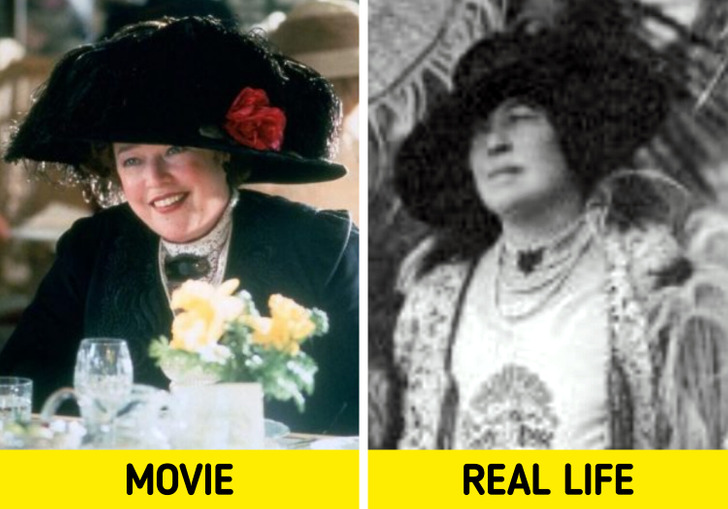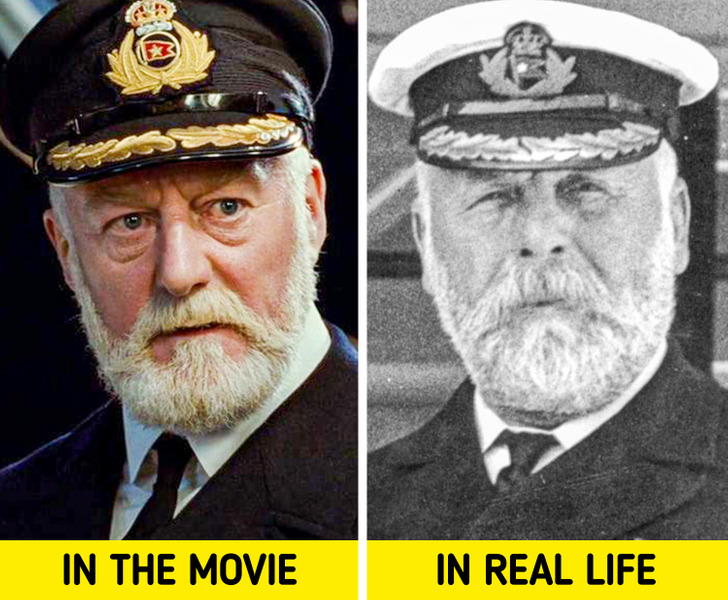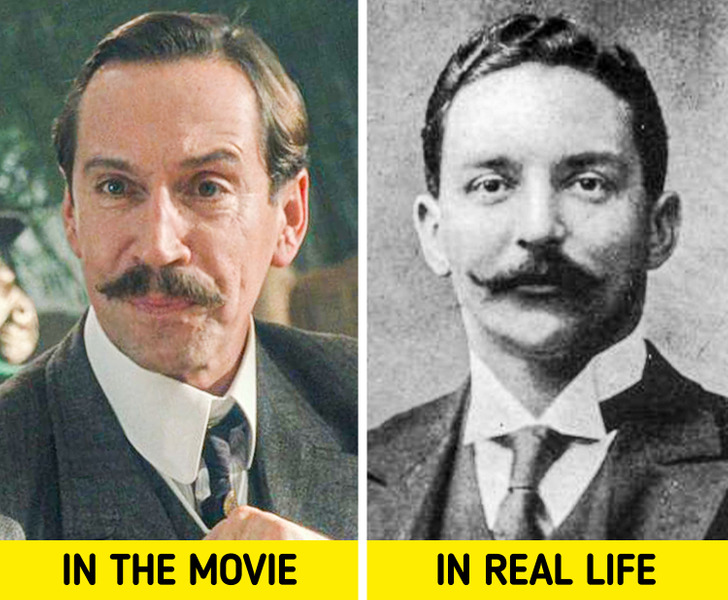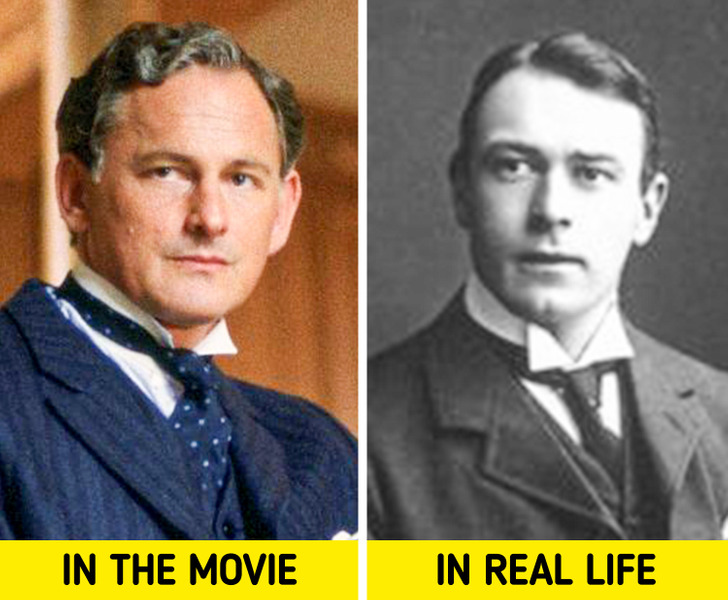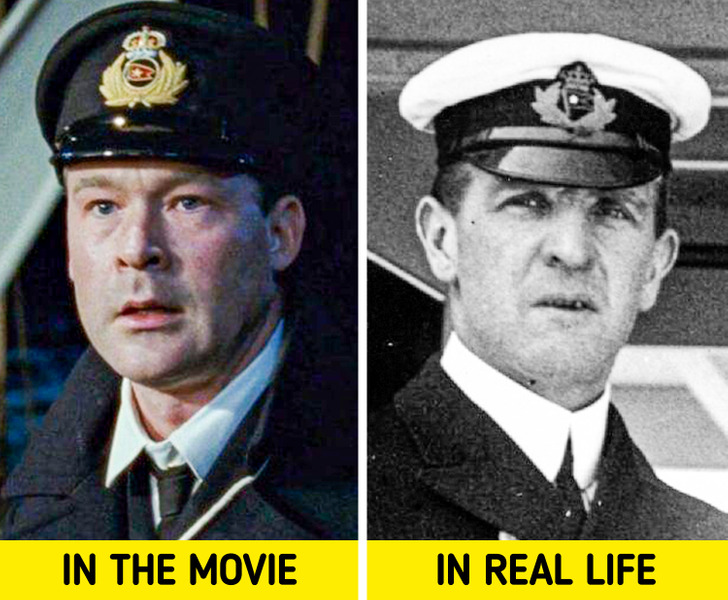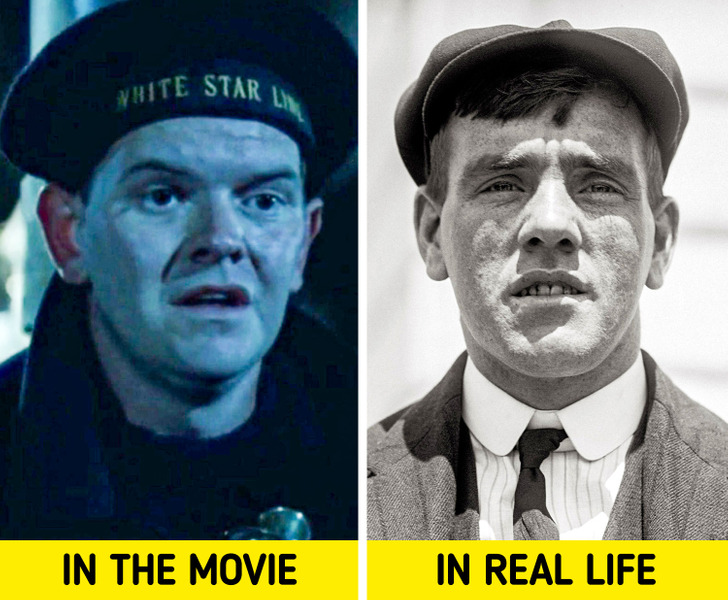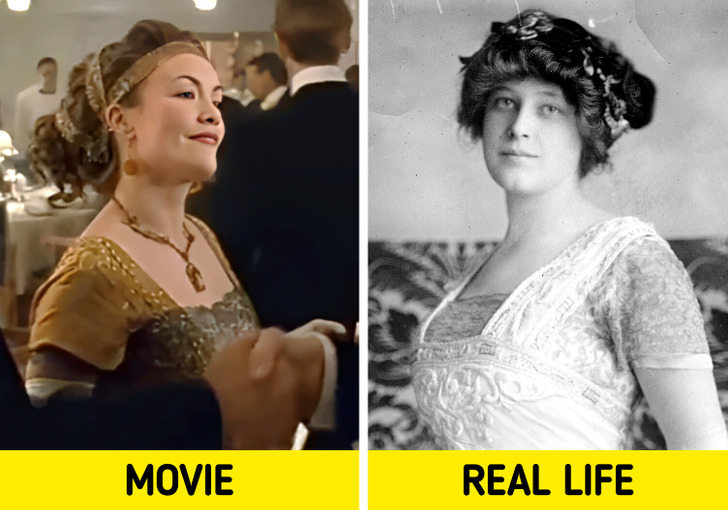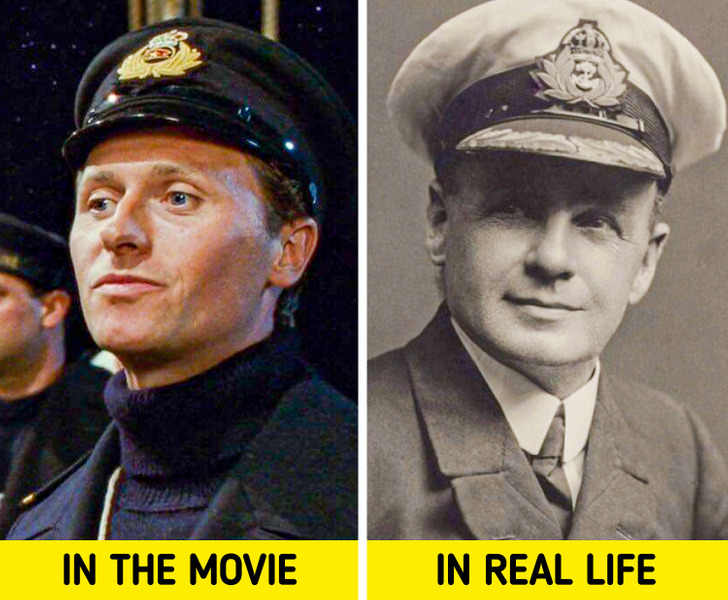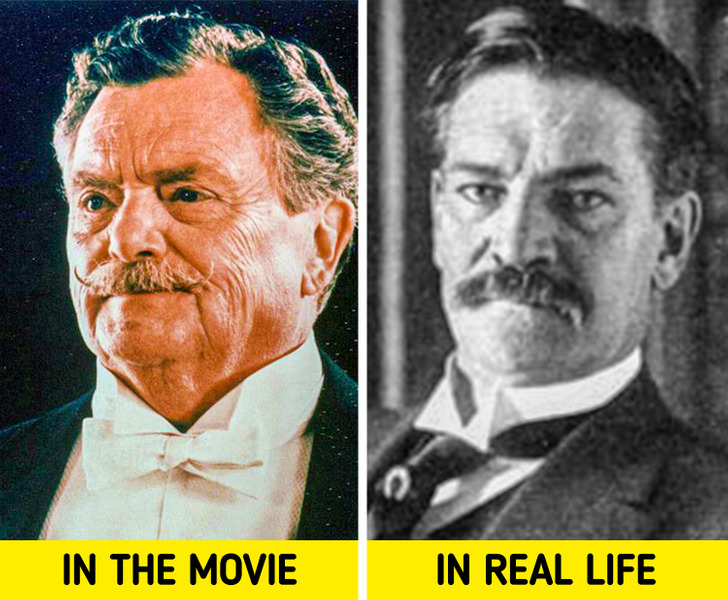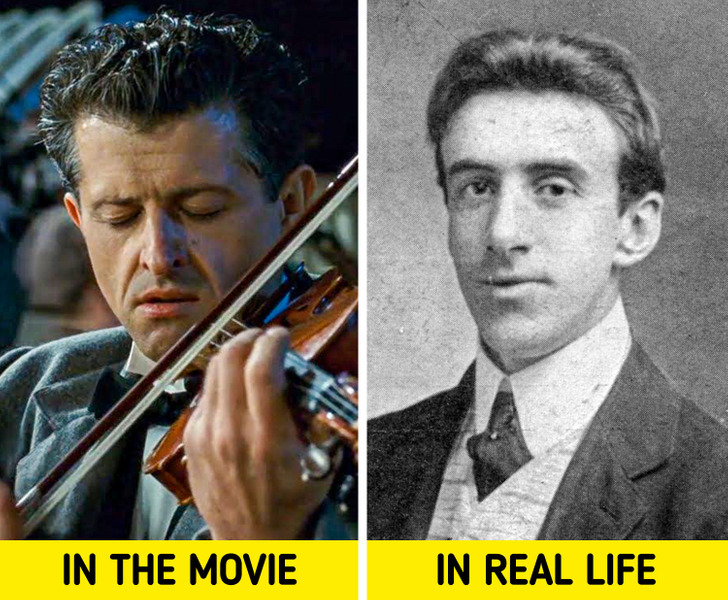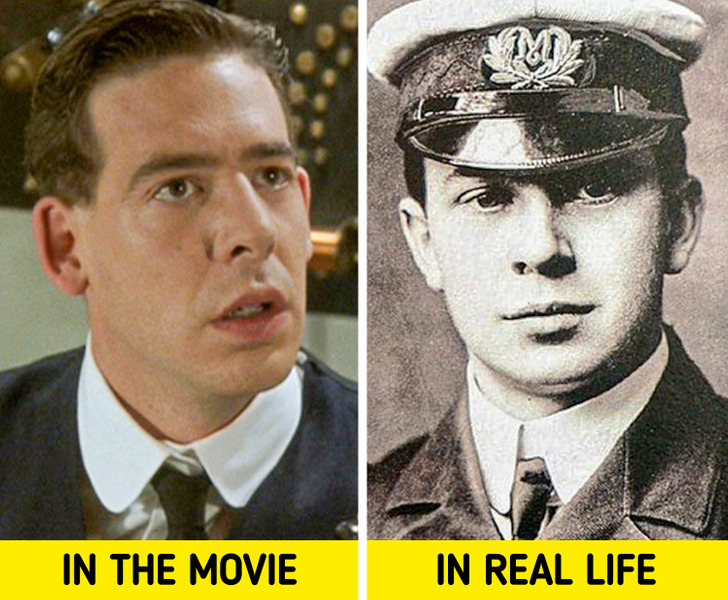Just heartbreaking.
11 Real Titanic Passengers That Made it Into the Movie
As dedicated fans of discovering intriguing movie facts, we embarked on a research journey to uncover the fascinating connection between real-life Titanic passengers and their appearance in the 1997 blockbuster film. Our investigation led us to these 12 individuals who experienced the historic tragedy firsthand and made their way onto the silver screen. Prepare to be amazed as we delve into the extraordinary overlap of their stories with the captivating world of cinema.
1. Margaret Brown
Margaret Brown, a philanthropist, public figure, and activist, was a passenger on the Titanic, as depicted in the movie where she lent Jack her son’s suit for dinner with the aristocrats. She was renowned for her selflessness and compassion towards others, exemplified by her heroic efforts to assist passengers into the lifeboats and her refusal to prioritize her safety until the end.
Even after being rescued by the ocean liner Carpathia, Margaret continued to show her altruistic nature by organizing a committee to raise funds and provide psychological support for disaster survivors. Her unwavering commitment to helping others earned her the nickname “The Unsinkable Molly Brown.”
2. Captain Edward Smith
Edward Smith, the commanding officer of the Titanic, hailed from a family of laborers and began his career as an apprentice in 1867, leaving school at 13. He was the White Star Line’s most seasoned captain, boasting over four decades of experience. The ill-fated voyage on the Titanic was intended to be his final journey before retiring from the sea.
During the voyage, there was a widely held belief that floating ice posed little threat to ships. In fact, in a 1907 interview, the future captain of the ship expressed his disbelief in a scenario where a modern vessel could sink.
3. J. Bruce Ismay
Joseph Bruce Ismay, the president and director of the White Star Line of steamships, sought to surpass his competitors by commissioning an opulent and unparalleled vessel, the Titanic. In doing so, he made the controversial decision to reduce the number of lifeboats on board from 48 to 16.
Following his rescue from the sinking ship, Ismay faced public backlash for allegedly abandoning the ship while women and children remained on board. He was forever branded a coward, a reputation that persisted until the end of his life.
Ismay’s unfavorable portrayal has been a recurring theme in cinematic adaptations of the story, including James Cameron’s iconic film. Despite a consultant’s suggestion to reconsider the character’s depiction, Cameron opted to maintain the original storyline.
4. Thomas Andrews
Thomas Andrews, the mastermind behind the design of the Titanic, was on board the ship’s maiden voyage to oversee his creation. When the vessel collided with an iceberg, Andrews was among the select few who became aware of the ship’s inevitable sinking.
In an effort to save lives, Andrews worked tirelessly to convince hesitant passengers to board the lifeboats and personally inspected cabins, encouraging individuals to don life jackets and make their way to the deck. Despite his valiant efforts, Andrews ultimately perished, having been last seen shortly before the Titanic’s complete submergence. In his final moments, Andrews hurled cots from the deck, hoping to provide floating devices for those struggling in the water.
5. John Jacob Astor
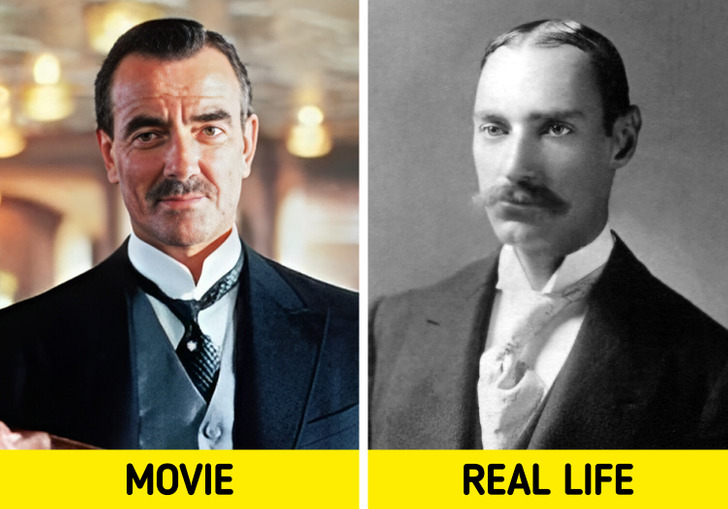
John Jacob Astor IV was a First Class passenger on the Titanic. He was an American self-made millionaire, businessman, inventor, writer, a member of the prominent Astor family, and a lieutenant colonel in the Spanish-American War.
Astor was the wealthiest passenger aboard the RMS Titanic and was thought to be among the richest people in the world at that time, with a net worth of roughly $87 million when he died (equivalent to $2.44 billion in 2021).
6. William McMaster Murdoch
William Murdoch, the first officer of the Titanic, was a seasoned sailor with years of experience under his belt. On the day of the tragedy, he was on watch and made every effort to prevent a collision. However, due to the late detection of the iceberg, the crew had only 37 seconds to react before the accident occurred.
The portrayal of Murdoch in James Cameron’s film was a subject of controversy, with his nephew expressing displeasure over the character’s complex and ambiguous depiction. To make amends, the film’s creators visited Murdoch’s hometown and made a donation to a memorial fund established in his honor.
7. Frederick Fleet
Frederick Fleet and his fellow lookout were responsible for spotting the iceberg on the fateful night of the Titanic’s sinking. Fleet testified before both the U.S. and British commissions investigating the disaster, claiming that he would have detected the iceberg sooner had he been provided with binoculars during the voyage.
Despite Fleet’s statement, some experts believe that using binoculars would not have made a significant difference in spotting the iceberg, given the darkness of the night. Fleet was later assigned to row the same lifeboat as the notable socialite Molly Brown and was ultimately rescued.
8. Madeleine Force
Madeleine Force, who was 18 at the time of the voyage, was the wife of John Jacob Astor IV. She boarded the Titanic as a first-class passenger in Cherbourg, France, with her husband; her husband’s valet, Victor Robbins; her maid, Rosalie Bidois; and her nurse, Caroline Endres. They also took Kitty, Astor’s pet Airedale, and occupied one of the parlor suites. Madeleine was five months pregnant when she boarded the ship.
9. Charles Lightoller
Charles Lightoller, the second mate of the Titanic, made a daring escape from the sinking ship by leaping off before being sucked into the vent. He managed to climb aboard an overturned collapsible dinghy, sharing the space with several other men. Lightoller demonstrated to his companions how to rock the boat to prevent it from capsizing. Despite his efforts, some men succumbed to exhaustion and fell overboard before the group was rescued at dawn.
Lightoller became a vocal advocate for improving passenger safety measures on ships as the highest-ranking disaster survivor. He proposed significant changes, including increasing the number of lifeboats, providing training on their use, establishing 24-hour radio communication with other vessels, and transmitting warnings about dangerous weather conditions. His efforts helped to shape modern safety standards for passenger transport on the high seas.
10. Archibald Gracie IV
Archibald Gracie IV, a distinguished writer and amateur historian, embarked on the Titanic’s maiden voyage as a first-class passenger. Gracie displayed remarkable courage and selflessness when the ship collided with an iceberg by assisting Second Officer Lightoller in evacuating women and children into the lifeboats. Following the vessel’s tragic sinking, Gracie was rescued in an overturned collapsible dinghy, but hypothermia severely impacted his health.
Despite his physical condition, Gracie was determined to document the events of that fateful night. Upon returning to New York, he began writing a memoir about his experience on the Titanic, which would later become a valuable resource for historians and researchers seeking to understand the disaster. Sadly, Gracie’s life was cut short less than eight months after the tragedy due to complications from diabetes.
11. Wallace Hartley
Few people were unmoved by the sequence in the film in which, despite the Titanic’s sinking, the orchestra continues to play music. This episode is based on real events. Wallace Hartley was the liner’s bandmaster, and after the collision with the iceberg, he and other musicians began to perform pieces to calm the passengers.
According to many witnesses, the orchestra continued to perform until the ship sank. The musicians were all killed. Hartley’s body was discovered tied up with his violin case by rescuers. Later, in 2006, the violin instrument was found, with a message from his fiancée scribbled on the back: “For Wallace on the occasion of our engagement from Maria.”
12. John “Jack” Phillips
On the day of the disaster, the Titanic’s radio operator, John “Jack” Phillips, was inundated with telegrams from passengers, as the radio transmitter had just broken down. Phillips, tired, neglected to convey to the captain iceberg warnings from adjacent ships. He didn’t even hear the last transmission from the closest vessel, which may have saved him from a collision.
When disaster struck, the captain directed that a distress signal be sent. And Jack Phillips didn’t stop transmitting for a single second until the transmission room flooded and the transmitter went down. Phillips was unable to be saved. Harold Bride, who worked with Jack, recalled, “I learned to love him that night and suddenly felt a great reverence to see him standing there, glued to his work, while everyone else was furious. I will never forget Phillips’ work for the last fifteen minutes.”
Titanic is undoubtedly a classic movie that has captured the hearts of audiences worldwide. However, even with its iconic status, there are still numerous mistakes that went unnoticed by many.
Comments
Related Reads
14 Eerie Twists That Completely Rewrite the Narrative

16 Riddles That Can Mislead Even the Brightest Mind

8 People Who Witnessed Unusual Sights That Defy Any Logic

10 People Whose Desk Is the Front Row Seat to a Daily Soap Opera

My Husband Called Me ’Fat’ so I Taught Him a Lesson He’ll Never Forget

13 Families Who Could Star in Their Own Dramatic Soap Opera

13 People Who Got Caught in Life’s Ironic Twists

My Fiancé’s Secret Christmas Plans Left Me Feeling Invisible

12 True Stories That Ended With the Most Crushing Plot Twists

10+ People Who Could Write a Novel With Their Workplace Stories

My Teenage Daughter is Shaking My Confidence as a Woman— I Decided to Send Her to Boarding School

My Husband Cruelly Abandoned Me During Childbirth, and Here’s How I Got Even

